Abstract
Rats raised on a low-iron diet were used as a model system for investigating the regulation of transferrin gene expression by iron deficiency. We quantitated transferrin mRNA in a variety of tissues from normal and iron-deficient rats and found that the level of transferrin mRNA in normal rat liver was about 6500 molecules per cell, while the level in iron-deficient animals was 2.4-fold higher. The increase of transferrin mRNA in iron deficiency was the result of a specific induction of transferrin gene transcriptional activity as measured in isolated nuclei. This increase in transferrin gene expression resulted in a corresponding increase in serum total-iron-binding capacity. Of the other tissues examined, moderate amounts of transferrin mRNA were found in brain (83 molecules per cell) and testis (114 molecules per cell), and low levels were measured in spleen and kidney. The transferrin mRNA content of brain, testis, spleen, and kidney remained unchanged in iron deficiency. The small intestine had no detectable transferrin mRNA in either normal or iron-deficient rats; however, transferrin protein was present, and its level was 2-fold higher in the iron-deficient group. We hypothesize that intestinal transferrin is synthesized in the liver and is delivered to the gut via the bile. Consistent with this idea, bile transferrin content was found to be elevated in iron deficiency and appeared to be sufficient to account for intestinal transferrin levels. In addition, treatment of plasma transferrin with bile caused an acidic shift in its isoelectric-focusing behavior so that it comigrated with intestinal transferrin.
Full text
PDF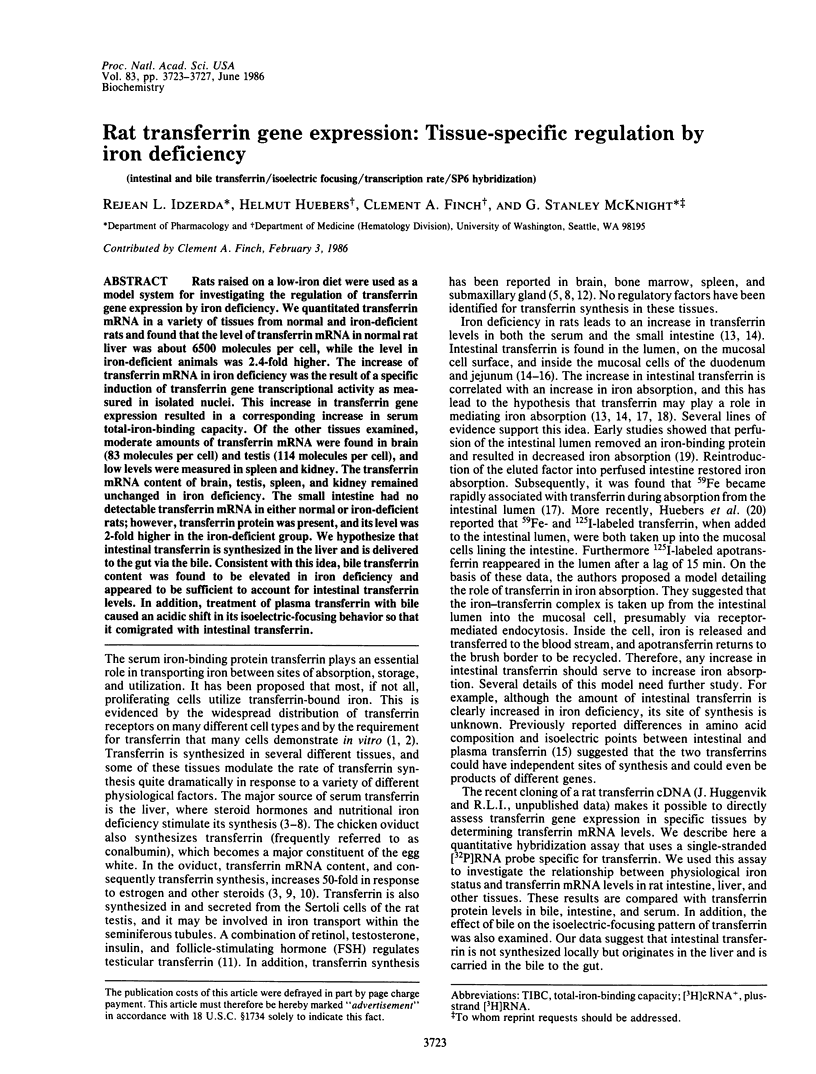
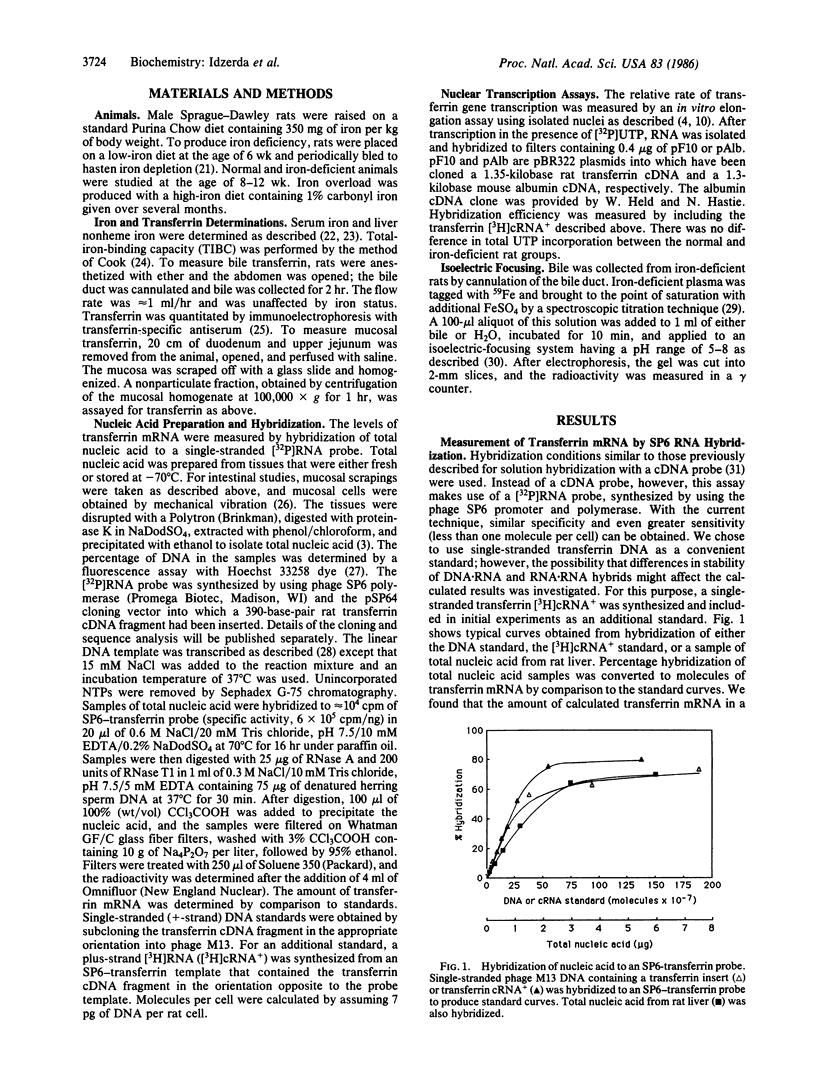
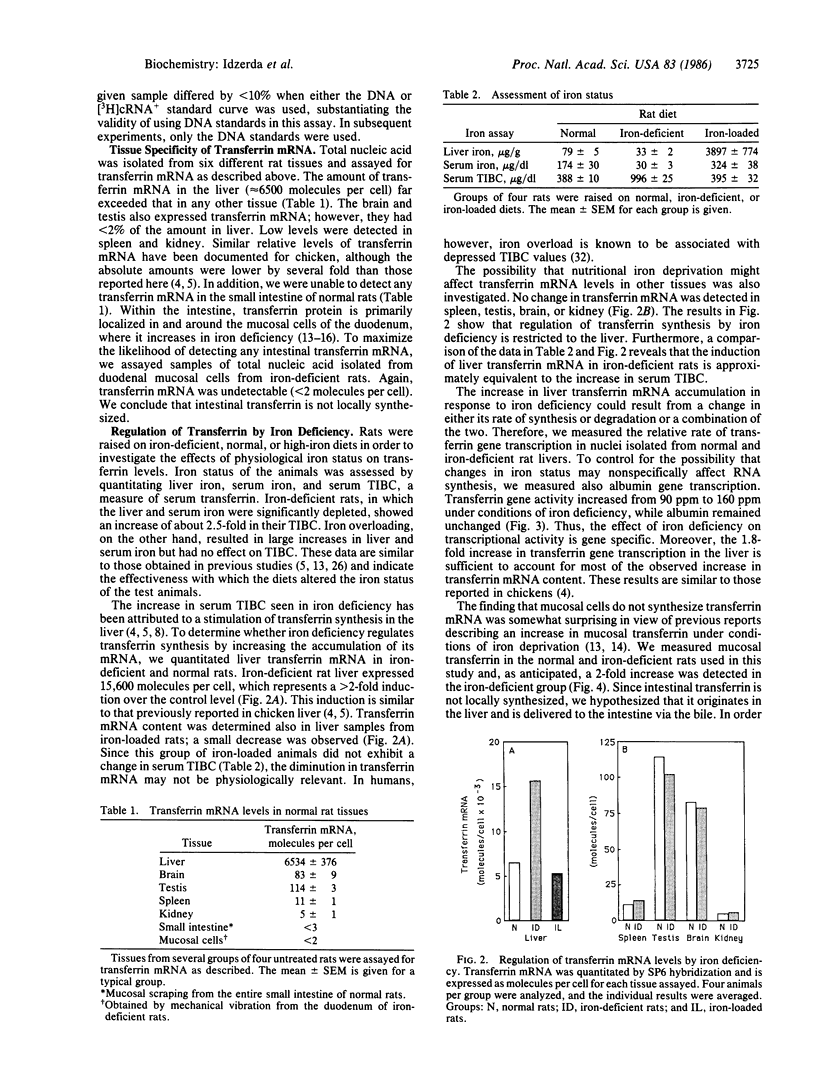
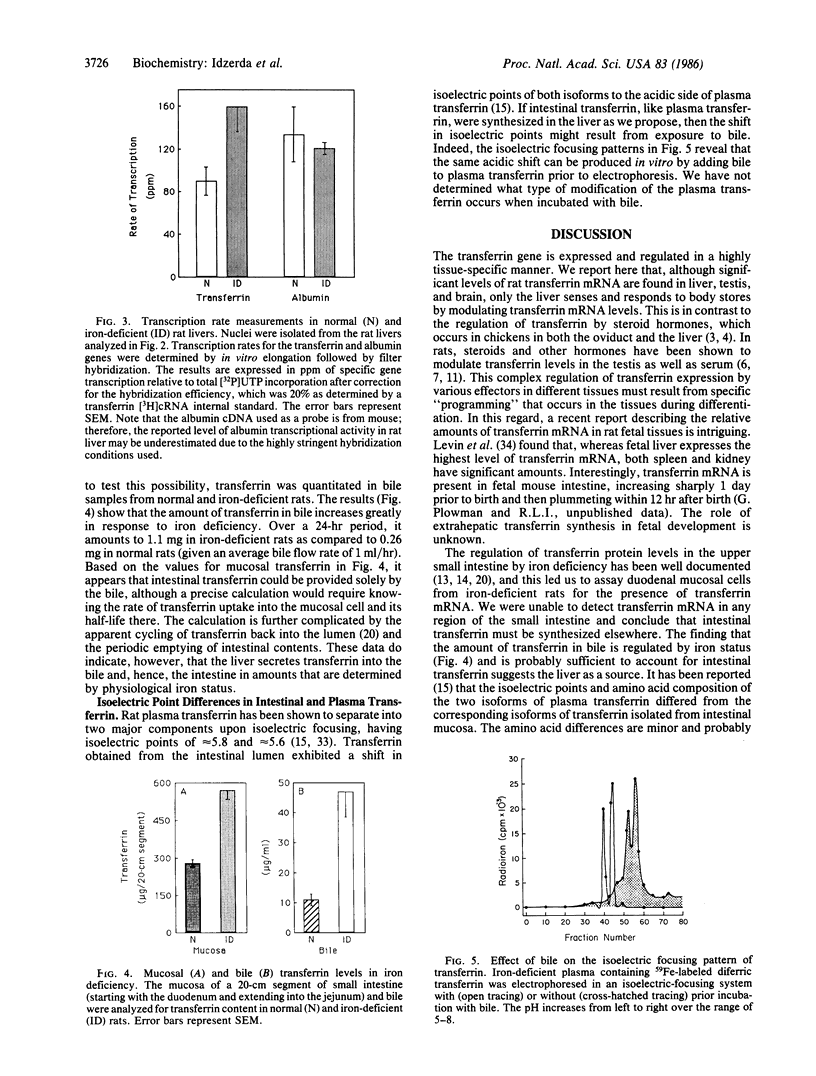
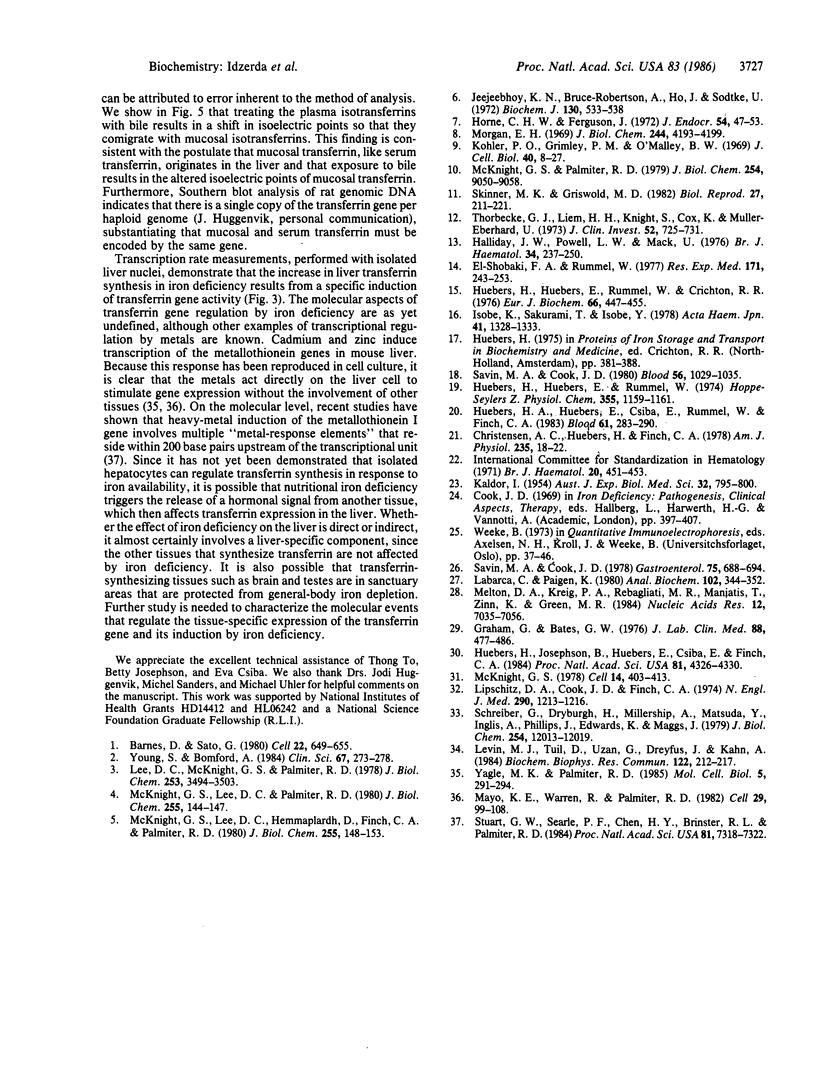
Images in this article
Selected References
These references are in PubMed. This may not be the complete list of references from this article.
- Barnes D., Sato G. Serum-free cell culture: a unifying approach. Cell. 1980 Dec;22(3):649–655. doi: 10.1016/0092-8674(80)90540-1. [DOI] [PubMed] [Google Scholar]
- El-Shobaki F. A., Rummel W. Mucosal transferrin and ferritin factors in the regulation of iron absorption. Res Exp Med (Berl) 1977 Dec 15;171(3):243–253. doi: 10.1007/BF01851508. [DOI] [PubMed] [Google Scholar]
- Grahm G., Bates G. W. Approaches to the standardization of serum unsaturated iron-binding capacity. J Lab Clin Med. 1976 Sep;88(3):477–486. [PubMed] [Google Scholar]
- Halliday J. W., Powell L. W., Mack U. Iron absorption in the rat: the search for possible intestinal mucosal carriers. Br J Haematol. 1976 Oct;34(2):237–250. doi: 10.1111/j.1365-2141.1976.tb00194.x. [DOI] [PubMed] [Google Scholar]
- Horne C. H., Ferguson J. The effect of age, sex, pregnancy, oestrogen and progestogen on rat serum proteins. J Endocrinol. 1972 Jul;54(1):47–53. doi: 10.1677/joe.0.0540047. [DOI] [PubMed] [Google Scholar]
- Huebers H. A., Huebers E., Csiba E., Rummel W., Finch C. A. The significance of transferrin for intestinal iron absorption. Blood. 1983 Feb;61(2):283–290. [PubMed] [Google Scholar]
- Huebers H. A., Josephson B., Huebers E., Csiba E., Finch C. A. Occupancy of the iron binding sites of human transferrin. Proc Natl Acad Sci U S A. 1984 Jul;81(14):4326–4330. doi: 10.1073/pnas.81.14.4326. [DOI] [PMC free article] [PubMed] [Google Scholar]
- Huebers H., Huebers E., Rummel W., Crichton R. R. Isolation and characterization of iron-binding proteins from rat intestinal mucosa. Eur J Biochem. 1976 Jul 15;66(3):447–455. doi: 10.1111/j.1432-1033.1976.tb10569.x. [DOI] [PubMed] [Google Scholar]
- Huebers H., Huebers E., Rummel W. Dependence of increased iron absorption by iron-defeficient rats on an elutable component of jejunal mucosa. Hoppe Seylers Z Physiol Chem. 1974 Sep;355(9):1159–1161. [PubMed] [Google Scholar]
- Isobe K., Sakurami T., Isobe Y. Studies on iron transport in human intestine by immunoperoxidase technique. I. The localization of ferritin, lactoferrin and transferrin in human duodenal mucosa. Nihon Ketsueki Gakkai Zasshi. 1978 Dec;41(6):1328–1333. [PubMed] [Google Scholar]
- Jeejeebhoy K. N., Bruce-Robertson A., Ho J., Sodtke U. The effect of cortisol on the synthesis of rat plasma albumin, fibrinogen and transferrin. Biochem J. 1972 Nov;130(2):533–538. doi: 10.1042/bj1300533. [DOI] [PMC free article] [PubMed] [Google Scholar]
- KALDOR I. Studies on intermediary iron metabolism. V. The measurement of non-haemoglobin tissue iron. Aust J Exp Biol Med Sci. 1954 Dec;32(6):795–799. doi: 10.1038/icb.1954.82. [DOI] [PubMed] [Google Scholar]
- Kohler P. O., Grimley P. M., O'Malley B. W. Estrogen-induced cytodifferentiation of the ovalbumin-secreting glands of the chick oviduct. J Cell Biol. 1969 Jan;40(1):8–27. doi: 10.1083/jcb.40.1.8. [DOI] [PMC free article] [PubMed] [Google Scholar]
- Labarca C., Paigen K. A simple, rapid, and sensitive DNA assay procedure. Anal Biochem. 1980 Mar 1;102(2):344–352. doi: 10.1016/0003-2697(80)90165-7. [DOI] [PubMed] [Google Scholar]
- Lee D. C., McKnight G. S., Palmiter R. D. The action of estrogen and progesterone on the expression of the transferrin gene. A comparison of the response in chick liver and oviduct. J Biol Chem. 1978 May 25;253(10):3494–3503. [PubMed] [Google Scholar]
- Levin M. J., Tuil D., Uzan G., Dreyfus J. C., Kahn A. Expression of the transferrin gene during development of non-hepatic tissues: high level of transferrin mRNA in fetal muscle and adult brain. Biochem Biophys Res Commun. 1984 Jul 18;122(1):212–217. doi: 10.1016/0006-291x(84)90461-3. [DOI] [PubMed] [Google Scholar]
- Lipschitz D. A., Cook J. D., Finch C. A. A clinical evaluation of serum ferritin as an index of iron stores. N Engl J Med. 1974 May 30;290(22):1213–1216. doi: 10.1056/NEJM197405302902201. [DOI] [PubMed] [Google Scholar]
- Mayo K. E., Warren R., Palmiter R. D. The mouse metallothionein-I gene is transcriptionally regulated by cadmium following transfection into human or mouse cells. Cell. 1982 May;29(1):99–108. doi: 10.1016/0092-8674(82)90094-0. [DOI] [PubMed] [Google Scholar]
- McKnight G. S., Lee D. C., Hemmaplardh D., Finch C. A., Palmiter R. D. Transferrin gene expression. Effects of nutritional iron deficiency. J Biol Chem. 1980 Jan 10;255(1):144–147. [PubMed] [Google Scholar]
- McKnight G. S., Lee D. C., Palmiter R. D. Transferrin gene expression. Regulation of mRNA transcription in chick liver by steroid hormones and iron deficiency. J Biol Chem. 1980 Jan 10;255(1):148–153. [PubMed] [Google Scholar]
- McKnight G. S., Palmiter R. D. Transcriptional regulation of the ovalbumin and conalbumin genes by steroid hormones in chick oviduct. J Biol Chem. 1979 Sep 25;254(18):9050–9058. [PubMed] [Google Scholar]
- McKnight G. S. The induction of ovalbumin and conalbumin mRNA by estrogen and progesterone in chick oviduct explant cultures. Cell. 1978 Jun;14(2):403–413. doi: 10.1016/0092-8674(78)90125-3. [DOI] [PubMed] [Google Scholar]
- Melton D. A., Krieg P. A., Rebagliati M. R., Maniatis T., Zinn K., Green M. R. Efficient in vitro synthesis of biologically active RNA and RNA hybridization probes from plasmids containing a bacteriophage SP6 promoter. Nucleic Acids Res. 1984 Sep 25;12(18):7035–7056. doi: 10.1093/nar/12.18.7035. [DOI] [PMC free article] [PubMed] [Google Scholar]
- Morgan E. H. Factors affecting the synthesis of transferrin by rat tissue slices. J Biol Chem. 1969 Aug 10;244(15):4193–4199. [PubMed] [Google Scholar]
- Savin M. A., Cook J. D. Iron transport by isolated rat intestinal mucosal cells. Gastroenterology. 1978 Oct;75(4):688–694. [PubMed] [Google Scholar]
- Savin M. A., Cook J. D. Mucosal iron transport by rat intestine. Blood. 1980 Dec;56(6):1029–1035. [PubMed] [Google Scholar]
- Schreiber G., Dryburgh H., Millership A., Matsuda Y., Inglis A., Phillips J., Edwards K., Maggs J. The synthesis and secretion of rat transferrin. J Biol Chem. 1979 Dec 10;254(23):12013–12019. [PubMed] [Google Scholar]
- Skinner M. K., Griswold M. D. Secretion of testicular transferrin by cultured Sertoli cells is regulated by hormones and retinoids. Biol Reprod. 1982 Aug;27(1):211–221. doi: 10.1095/biolreprod27.1.211. [DOI] [PubMed] [Google Scholar]
- Stuart G. W., Searle P. F., Chen H. Y., Brinster R. L., Palmiter R. D. A 12-base-pair DNA motif that is repeated several times in metallothionein gene promoters confers metal regulation to a heterologous gene. Proc Natl Acad Sci U S A. 1984 Dec;81(23):7318–7322. doi: 10.1073/pnas.81.23.7318. [DOI] [PMC free article] [PubMed] [Google Scholar]
- Thorbecke G. J., Liem H. H., Knight S., Cox K., Muller-Eberhard U. Sites of formation of the serum proteins transferrin and hemopexin. J Clin Invest. 1973 Mar;52(3):725–731. doi: 10.1172/JCI107234. [DOI] [PMC free article] [PubMed] [Google Scholar]
- Yagle M. K., Palmiter R. D. Coordinate regulation of mouse metallothionein I and II genes by heavy metals and glucocorticoids. Mol Cell Biol. 1985 Feb;5(2):291–294. doi: 10.1128/mcb.5.2.291. [DOI] [PMC free article] [PubMed] [Google Scholar]
- Young S., Bomford A. Transferrin and cellular iron exchange. Clin Sci (Lond) 1984 Sep;67(3):273–278. doi: 10.1042/cs0670273. [DOI] [PubMed] [Google Scholar]




